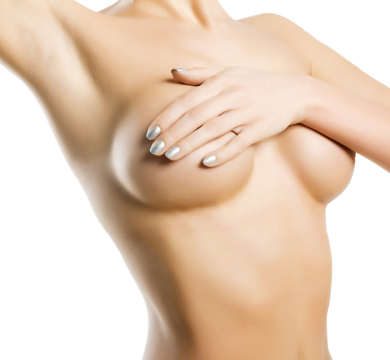If the implant has settled too much, the breast can have a bottomed out appearance. This can be caused by over-dissection at surgery or can be a natural occurrence of the implant settling depending on the size of the implant and the patient’s tissue characteristics. This problem can be corrected by performing a capsulorrhaphy to raise the implant. The capsulorrhaphy is performed under general anesthesia. The incision usually needs to be made under the breast or around the nipple in order to have good enough access to raise the implant using suture techniques.
Sometimes a surgeon may attempt to give the patient more cleavage and the result can be very undesirable and the patient can develop a condition known as symmastia. Symmastia usually occurs when over-dissection is performed medially. This can result in the breast implant pockets becoming joined, resulting in the so-called “uni-boob”.
Problems with Patient Tissue Characteristics
Tuberous breasts present a challenge for breast augmentation. Women with very narrow breasts and a short distance from the nipple to the inframammary fold need special considerations at the time of their breast augmentation. Failure to address these issues may result in patient dissatisfaction.
Thinning of the breast tissues from aging or an excessively large implant may make a patient prone to implant extrusion. Treatment may involve complete removal of the implant to allow for appropriate healing before replacing the implant. In some cases, replacing the implant may not be a viable option.
If you have large areolas (the darker skin around the nipple) prior to breast augmentation, this may get larger after placing implants. Areola reduction procedures involve an incision around the areola. This may leave a noticeable scar, but is the only way to reduce areola size.
Most women are asymmetric prior to breast augmentation. Some asymmetry should be expected, however, if the patient has very noticeable asymmetry, corrective surgery may be necessary.
Droop of the breasts over time can occur from thin inelastic skin, poor tissue quality (often accompanied by stretch marks), large implant size, or implants that are placed above the muscle in women with pre-existing droop. A breast lift and exchange of the breast implant may be needed to correct this problem.
Snoopy nose deformity is a problem that occurs when a patient with some droop to her breasts gets implants placed underneath the pectoralis muscle. The implant stays in a superior position, however, the sagging breast tissue hangs over the implant and looks like snoopy’s nose. The problem can be corrected by doing a breast lift or by placing the implants in a submammary position. If the implants are placed in a submammary position, they will not have the same fullness in the upper portion of the breast and will appear droopier in nature.
Double bubble is a problem where the implant forms a ridge underneath the existing breast fold. This can be caused by a patient’s own tissue characteristics or by placing the implant too far inferiorly. The treatment may involve raising the implant or placing the implant above the muscle. Revision breast surgery depends on the specific cause of the double bubble.
Rippling of the skin surface may occur after having implants. It is more common when implants are placed above the muscle or when a large implant is used or the patient has thin tissues covering the implant. Saline implants are more prone to rippling than silicone gel implants. The treatment may involve placement of a smaller implant or switching from saline to silicone gel implants.
Problems with the Implant
Deflation or implant rupture is a problem with saline or silicone gel breast implants. With saline implants, you will notice your breasts becoming flat within a couple of days. With silicone gel implant, patient can have a silent rupture, where the patient does not even know the implant is ruptured or leaking. The only way to diagnose silent ruptures with silicone gel implants is to obtain an MRI. In either case, if your implant is ruptured, you will need to have it removed or replaced. The implant manufacturers offer warranties on the implants that may cover the costs of the implant and the surgery.
Capsular contracture is a nuisance problem where the scar tissue around the implant becomes thickened and tightens around the implant. We do not know what causes capsular contracture and it can be a very frustrating problem for some women. In some cases treatment may only involve massaging the implants. In more severe cases, you may require revision surgery to remove the capsule (capsulectomy) and replace the implant. Patient that have developed capsule contracture are more likely to develop it again with future surgeries. Silicone implants may be more prone to developing this problem as compared to saline implants.
Call our office today for a consultation with Dr. Murtagh: 239-947-FACE (3223).




